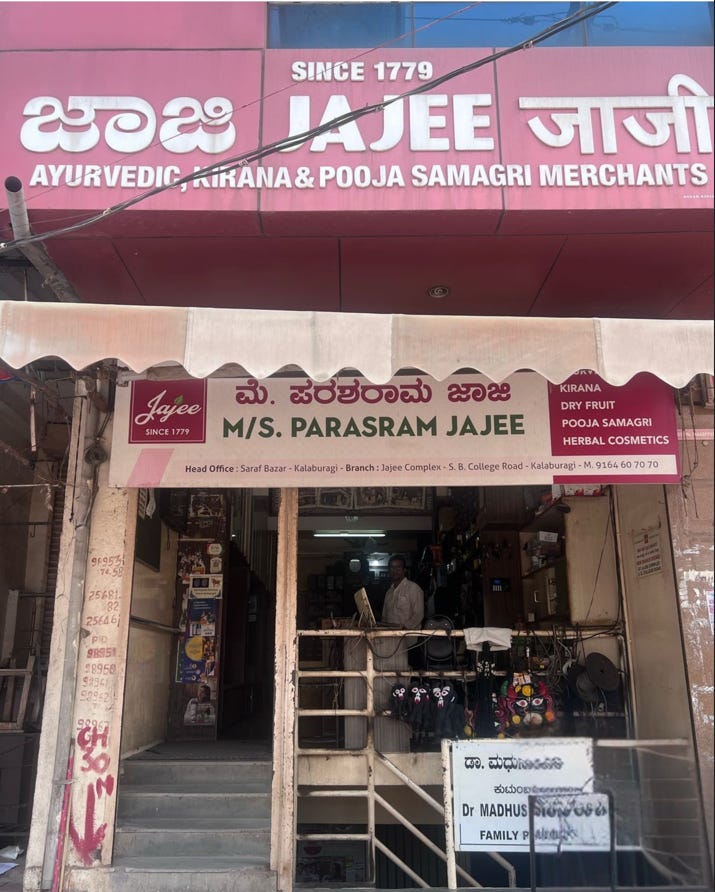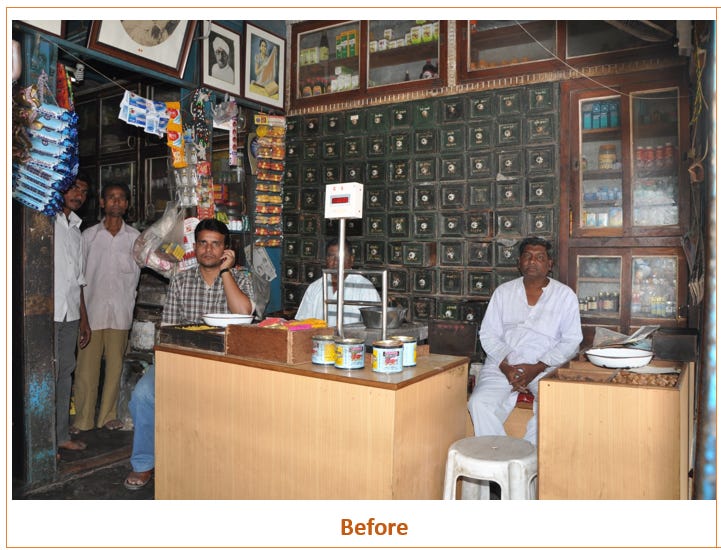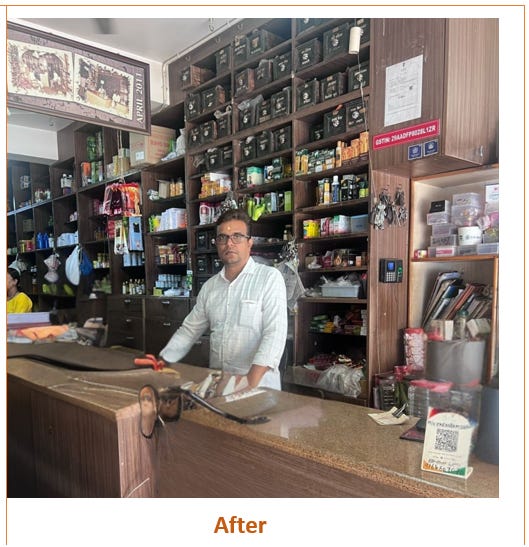Product Lessons a 245-Year-Old Store Taught Me
Lessons in friction, flow, and customer-first thinking that every product team should hear
I didn’t expect to find product wisdom on a scorching afternoon in Kalaburgi.
But that’s exactly what happened.
I was catching up with an old friend—Raghavendra Jajee, or Raghu as we call him—who now runs his family’s retail store selling Ayurvedic goods, dry fruits, pooja items, herbal cosmetics, and more in the heart of Kalaburgi’s bustling market.
It’s not just any shop.
M/s Parasram Jajee, founded in 1779, has been quietly serving generations of customers for nearly 250 years. The store stocks over 2,500 unique SKUs, mostly wellness and Ayurvedic products, and sees nearly 1,000 footfalls on a busy day.
You’d think with that kind of traffic, business would have been booming for decades.
But Raghu shared something unexpected.
“It was flat a few years ago,” he said.
“Same revenue. Month after month. Year after year. We weren’t losing customers—but we weren’t growing either.”
And that bothered him.
So he did something most people don’t.
One morning, he just... observed.
He parked himself behind the counter—no dashboards, no reports, no tools—just eyes and ears, wide open.
And what he saw made him deeply uncomfortable.
Customers were walking in steadily—mostly from nearby villages, operating on tight bus schedules and even tighter shopping windows. They’d request an item. The sales assistant would run to the back. By the time they returned, the customer had remembered another product. Off the assistant went again.
Meanwhile, the line grew. Customers waited, grew restless—and then simply walked away.
“Every customer who walked off wasn’t just a lost sale,” Raghu said.
“It was lost respect. We were wasting their time—and it was hurting our reputation.”
So he stepped into their shoes.
He obsessed over their urgency.
He mapped the experience not as a business owner—but as a customer in a hurry.
He asked himself not, “How do I sell more?”
But, “How do I make it faster and easier for them to buy?”
That shift sparked a quiet revolution.
Here’s what Raghu changed:
Expanded the sales counter from two to six people—serving customers in parallel and slashing wait times.
Reorganized the layout—moving top-selling items to the front and less frequent ones to the back.
Created festival combo packs—bundling high-demand products for Diwali, Holi, Dasara, and other events.
Incentivized the sales team with per-item commissions—turning them into active sellers, not passive clerks.
Placed impulse-friendly products near the counter to drive add-ons and increase value per customer.
Invested in technology and procurement partnerships—bringing in high-quality, fairly priced goods from across the country.
Launched an online platform to serve city-wide customers—extending the store’s legacy beyond its physical walls and enabling time-strapped buyers to browse, bundle, and buy from anywhere in the world. Check it out —> https://jajee.in
The result?
Word spread.
“Go to Jajee’s,” people started saying.
“They know what you need—even before you say it.”
Sales grew.
Customer experience improved.
People came back—not just for the products, but for how the experience made them feel.
Raghu wasn’t just running a shop anymore.
He was orchestrating a well-oiled, customer-first system—where speed, empathy, and flow mattered more than inventory size.
So, what can product managers learn from this?
Raghu never built something new. He refined what was already there—with observation, empathy, and clarity of intent.
And that’s where real product leadership begins.
Because sometimes the biggest unlocks don’t come from adding features.
They come from removing friction.
Raghu didn’t ask what more he could give his customers.
He asked what was getting in their way.
When we, as PMs, stop chasing the next shiny roadmap item and start removing obstacles in the current experience, magic happens.
He showed us that:
🟢 Observation beats assumption.
The best ideas rarely come from a dashboard—they come from silent patterns and customer behavior hiding in plain sight.
🟢 User urgency matters more than product features.
Most users don’t want more. They want faster. They want simpler. They want to finish and move on.
🟢 Removing friction is more powerful than adding flair.
Real delight isn’t always visible. It’s often felt in the absence of resistance.
🟢 Empathy drives monetization.
When you understand your users’ journey deeply, you don’t have to sell harder—you just make it easier for them to buy.
🟢 The best innovations are often invisible.
A well-placed product, a reduced wait, a faster checkout—these don’t trend on social media, but they create loyalty that lasts.
So the next time your product growth stalls…
The next time your backlog feels bloated…
The next time you’re unsure what to build next…
Pause.
Walk to your metaphorical counter.
Watch your users.
And ask yourself—
Where are they still waiting?
And what can I remove to help them move forward?





Loved the blog and podcast, Sandeep! The way you presented everything was excellent—it really showed how well you grasp and apply best practices, and how effectively you communicate them. I also truly appreciate the recognition given to Raghu’s achievement. Running an established business, driving continuous improvement, and still staying #1 is no easy feat.
This story shares a valuable corporate lesson. Often, we get so focused on chasing big goals that we overlook the importance of improving and excelling in our daily work. It’s those small, consistent efforts that create long-term success. Raghu’s journey is a great example of how ongoing improvement, even in traditional industries, can lead to lasting excellence.
Really appreciate your effort in sharing this insightful piece. Thanks again!
A perceptive article on an innovative business remodeling. I am friends with both Raghu and Sandeep. But I didn't appreciate what Raghu has done fully till I read this excellent article by Sandy(we call Sandeep Mahagaonkar as Sandy). So in a way, by reading Sandy's posts I am also appreciating Sandy' s growth. I am proud of them both. I am a dentist by profession and for me a simple motto exists: improve skill, decrease chair side time, and money will take care of itself. But after reading this article, I am inspired to think beyond my comfort zone and reassess my dental practice as business model. Thanks Sandy, for opening my eyes.. I look forward to more such inspiring posts!